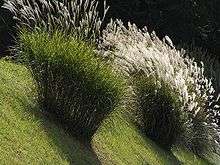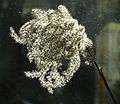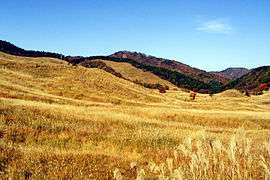Miscanthus sinensis
Miscanthus sinensis, the maiden silvergrass,[1] is a species of flowering plant in the grass family Poaceae, native to eastern Asia throughout most of China, Japan, Taiwan and Korea. It is an herbaceous perennial grass, growing to 0.8–2 m (3–7 ft) tall, rarely 4 m (13 ft), forming dense clumps from an underground rhizome. The leaves are 18–75 cm (7–30 in) tall and 0.3–2 cm broad. The flowers are purplish, held above the foliage. This plant is the preferred structure for the nesting of some species of paper wasps, such as Ropalidia fasciata.[2]
| Miscanthus sinensis | |
|---|---|
 | |
| Scientific classification | |
| Kingdom: | Plantae |
| Clade: | Tracheophytes |
| Clade: | Angiosperms |
| Clade: | Monocots |
| Clade: | Commelinids |
| Order: | Poales |
| Family: | Poaceae |
| Genus: | Miscanthus |
| Species: | M. sinensis |
| Binomial name | |
| Miscanthus sinensis Andersson (1855) | |
Nomenclature
Common names include Korean uksae,[3] Chinese silver grass, Eulalia grass, maiden grass, zebra grass, Susuki grass (ススキ), and porcupine grass. The Latin Miscanthus comes from the Greek for "stalk" and "flower".[4] The qualifier sinensis means "from China",[5] though the plant is found elsewhere in eastern Asia.
Forms and varieties
Cultivation
It is widely cultivated as an ornamental plant in temperate regions around the world.
It has become an invasive species in parts of North America.[6] However, it is possible to reduce the likelihood of escape or hybridization with extant wild M. sinensis populations with breeding and proper management.[7]
Cultivars
Several cultivars have been selected, including 'Strictus' with narrow growth habit, 'Variegata' with white margins, and ‘Zebrinus’ (sometimes incorrectly rendered as 'Zebrina') with horizontal yellow and green stripes across the leaves. Those marked agm have gained the Royal Horticultural Society's Award of Garden Merit.[8]
- 'Border Bandit'
- 'Cosmopolitan' agm[9]
- 'Dronning Ingrid'
- 'Ferner Osten' agm[10]
- 'Flamingo' agm[11]
- 'Gewitterwolke' agm[12]
- 'Ghana' agm[13]
- 'Gold und Silber' agm[14]
- 'Gracillimus'
- 'Grosse Fontäne' agm[15]
- 'Kaskade' agm[16]
- 'Kleine Fontäne' agm[17]
- 'Kleine Silberspinne' agm[18]
- 'Malepartus'
- 'Morning Light' agm[19]
- 'Septemberrot' agm[20]
- 'Silberfeder' agm[21]
- 'Strictus' agm[22]
- 'Undine' agm[23]
- 'Variegatus'
- 'Zebrinus' agm[24]
 Miscanthus sinensis 'Zebrinus'
Miscanthus sinensis 'Zebrinus' Miscanthus sinensis 'Strictus', Blüte
Miscanthus sinensis 'Strictus', Blüte Miscanthus sinensis 'Ferner Osten'
Miscanthus sinensis 'Ferner Osten' Miscanthus sinensis 'Malepartus', Blüte
Miscanthus sinensis 'Malepartus', Blüte
Uses
M. sinensis is a candidate for bioenergy production due to its high yield, even in high stress environments, easy propagation, effective nutrient cycling, and high genetic variation.[25]
Synonyms
- Eulalia japonica Trin.
- Saccharum japonicum Thunb.
Gallery

 Zebra grass with horizontal variegations, mostly a garden plant in Japan
Zebra grass with horizontal variegations, mostly a garden plant in Japan M. sinensis in Japan
M. sinensis in Japan Magnified view of M. sinensis leaf;
Magnified view of M. sinensis leaf;
0 to 1 = 1 mm; the saw-like edge can cut human skin.
References
- Lee, Sangtae; Chang, Kae Sun, eds. (2015). English Names for Korean Native Plants (PDF). Pocheon: Korea National Arboretum. p. 541. ISBN 978-89-97450-98-5. Retrieved 7 March 2019 – via Korea Forest Service.
- Ito, K (1992). "Relocation of Nests by Swarms and Nest Reconstruction in Late Autumn in the Primitively Eusocial Wasp, Ropalidia fasciata with Discussions on the Role of Swarming". Journal of Ethology. 109 (2): 109–117. doi:10.1007/BF02350115.
- "an uksae grass in Seoul".
- Coombes, Allen J. (2012). The A to Z of plant names. USA: Timber Press. pp. 312. ISBN 9781604691962.
- Harrison, Lorraine (2012). RHS Latin for gardeners. United Kingdom: Mitchell Beazley. p. 224. ISBN 9781845337315.
- Chinese silvergrass. Invasive.org: Center for Invasive Species and Ecosystem Health, February 2, 2010. Accessed May 28, 2010.
- Quinn LD, Allen DJ, Stewart JR (2010) Invasiveness potential of Miscanthus sinensis: implications for bioenergy production in the United States. Global Change Biology Bioenergy. 1-2, 126-153.
- "AGM Plants - Ornamental" (PDF). Royal Horticultural Society. July 2017. p. 64. Retrieved 4 April 2018.
- "RHS Plant Selector - Miscanthus sinensis 'Cosmopolitan'". Retrieved 24 May 2013.
- "RHS Plant Selector - Miscanthus sinensis 'Ferner Osten'". Retrieved 24 May 2013.
- "RHS Plant Selector - Miscanthus sinensis 'Flamingo'". Retrieved 24 May 2013.
- "RHS Plant Selector - Miscanthus sinensis 'Gewitterwolke'". Retrieved 24 May 2013.
- "RHS Plant Selector - Miscanthus sinensis 'Ghana'". Retrieved 24 May 2013.
- "RHS Plant Selector - Miscanthus sinensis 'Gold und Silber'". Retrieved 24 May 2013.
- "RHS Plant Selector - Miscanthus sinensis 'Grosse Fontane'". Retrieved 24 May 2013.
- "RHS Plant Selector - Miscanthus sinensis 'Kaskade'". Retrieved 24 May 2013.
- "RHS Plant Selector - Miscanthus sinensis 'Kleine Fontane'". Retrieved 24 May 2013.
- "RHS Plant Selector - Miscanthus sinensis 'Kleine Silberspinne'". Retrieved 24 May 2013.
- "RHS Plant Selector - Miscanthus sinensis 'Morning Light'". Retrieved 24 May 2013.
- "RHS Plant Selector - Miscanthus sinensis 'Septemberrot'". Retrieved 24 May 2013.
- "RHS Plant Selector - Miscanthus sinensis 'Silberfeder'". Retrieved 24 May 2013.
- "RHS Plant Selector - Miscanthus sinensis 'Strictus'". Retrieved 24 May 2013.
- "RHS Plant Selector - Miscanthus sinensis 'Undine'". Retrieved 24 May 2013.
- "RHS Plant Selector - Miscanthus sinensis 'Zebrinus'". Retrieved 24 May 2013.
- Stewart R, Toma Y, Fernández FG, Nishiwaki A, Yamada T, Bollero G (2009) The ecology and agronomy of “Miscanthus sinensis”, a species important to bioenergy crop development, in its native range in Japan: a review. Global Change Biology Bioenergy. 1-2, 126-153.
External links
| Wikimedia Commons has media related to Miscanthus sinensis. |